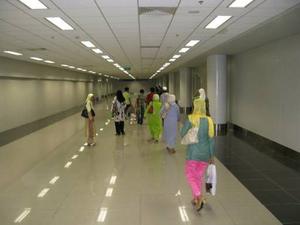Aviation securityIATA unveils plan for airport security tunnels
The International Air Transport Association unveiled a plan to replace lengthy and sometimes intrusive passenger security checks at airports with a new system aimed at finding “bad people, not bad objects”; under the project, an early version of which could be in place within 2-3 years if governments cooperate, travelers would be directed down one of three security tunnels depending on profiles based on biometric data and flight booking data; the IATA plan would eliminate the need for nearly all intrusive screening as well as routine scanning and searches of carry-on luggage; IATA says the system would not be based on racial or ethnic profiling

A solution for intrusive searches // Source: silent-gardens.com
The airline industry body IATA unveiled a plan on Tuesday to replace lengthy and sometimes intrusive passenger security checks at airports with a new system aimed at finding “bad people, not bad objects.”
Under the project, an early version of which could be in place within 2-3 years if governments cooperate, travelers would be directed down one of three security tunnels depending on profiles based on biometric data and flight booking data. “The current system of putting everyone through the same procedure — taking off shoes, pulling out laptops — is an incredible mess. It is causing longer and longer delays,” said IATA director-general Giovanni Bisignani.
“With today’s terror threats, we need to be able to find bad people, not bad objects. We can only do that by assessing passengers for risk with appropriate security checks to follow,” he told journalists at the body’s Geneva headquarters.
Air Transport World reports that Bisignani was speaking at a media briefing held every year by IATA, the 230-member International Air Transport Association, at which he announced the industry would return to profit this year and next at higher levels than expected. Airport security has mushroomed since the 9/11 attacks on U.S. targets by al Qaeda militants using hijacked passenger planes and subsequent attempts by suicide bombers to detonate inflight explosives, including a failed attempt by a Nigerian man on a U.S.-bound plane last Christmas Day.
Anger at stepped-up airport security procedures — including full-body scanners and “pat-down” manual body searches, widespread in the United States — has spilt over recently with traveler revolts against the systems.
The procedures have also caused diplomatic incidents, as when the Indian ambassador in Washington was subjected earlier this month to an airport pat-down in Mississippi and her government complained.
The IATA plan — which Bisignani said had been in the works for some time before the U.S. passenger revolts — would eliminate the need for nearly all such screening as well as routine scanning and searches of carry-on luggage. After checking in heavy bags and passing passport controls, travelers would identify themselves at security with a fingerprint, biometric passport or mobile phone boarding pass, and be checked electronically against their stored profile.
They would then be automatically assigned to one of the tunnels — one for registered “known travelers” where checks would be light, one where checks would be at “normal security” level, and the third an “enhanced security” lane.
In the first two tunnels, most passengers would walk with hand luggage past sophisticated electronic detector devices and into the departure lounge if nothing unusual is registered. Bisignani said the profile would be based on details travelers provide when buying their ticket, including whether they had paid by cash or credit card, and would be checked by national security or intelligence services.
IATA global security director Ken Dunlap said, however, that the system would not be based on racial or ethnic profiling. “We are completely opposed to checking people by the color of their skin or by their nationality,” he added.
Dunlap said IATA was discussing the plan with governments, which would have to finance it. If an intermediate version were in place by 2014 in key airports, a full one could be working within seven to ten years.
